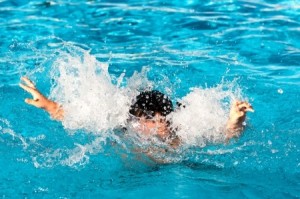 It’s a terrifying thing to think about – your baby falling into the water in the exact moment your attention has been redirected elsewhere. According to the CDC, fatal drowning is the second-leading cause of unintentional injury-related death (behind motor vehicle accidents) for children between the ages of 1 and 14.
It’s a terrifying thing to think about – your baby falling into the water in the exact moment your attention has been redirected elsewhere. According to the CDC, fatal drowning is the second-leading cause of unintentional injury-related death (behind motor vehicle accidents) for children between the ages of 1 and 14.
With statistics such as that, it’s no wonder parents are searching for ways to protect their infants from drowning. Many parents are turning to survival type swim lesson programs, which may be doing more harm than good.
What is Survival Swim Training?
Simply put, survival type training, as opposed to child centered training, is a technique used to teach babies and children. It teaches the swimmer to float on his back if he suddenly finds himself emerged. To most parents, this sounds like a great skill for a child to have, and we agree. However, the techniques used to teach this skill has prompted significant controversy and, in our opinions, can cause unnecessary trauma to the child.
Ultimately, these types of lessons teach by simulating drowning scenarios with the intention that the child will learn to float on his back. For very short durations over 5-10 consecutive days, babies are continually submerged under the surface, either being released so they go under on their own or pushed under by the instructor. The instructor then manipulates the baby’s body to flip over and float, with the intention that the reaction will become a learned behavior.
Why Are Survival Type Swim Lessons Bad for My Baby?
In survival type classes, babies are repeatedly submerged underwater while their parents look on from outside the pool. Babies cry and scream, unable to understand what is happening. The concept is that over time, the babies will learn to flip themselves over and float. In the process, they inhale water, panic, and often develop a lifelong fear of water.
During these types of classes, lessons need to periodically be put on hold so babies can burp and spit-up the water and air they have inhaled. While the child screams out, parents are instructed to cheer for the baby and not offer help. After lessons conclude, babies lay on their left side for a period of time to help them get the remaining water and air out of their lungs and stomach. While babies are enrolled in survival type classes, parents are required to carefully track the child’s urination and bowel movements for signs of hyponatremia or water intoxication. Additionally, parents watch for vomiting, unusual exhaustion, coughing, and trouble breathing, which could be signs of dry drowning or secondary drowning.
Aside from what we see as physical dangers associated with survival type classes, we recognize the emotional impact classes have on babies. The trauma of survival type classes often leads to a fear of the water and distrust of swim instructors, teachers, and even the parent that watches from the side of the pool.
What makes SCSC different?
We want our students to be safe, to trust their instructors, and enjoy swimming. We want them to laugh and love coming to class. We want to create life-long swimmers who can appreciate the joys of water their entire lives! And in order to do that, we have to make swimming an enjoyable priority. We do this by making our classes fun while incorporating safety and swimming skills. SCSC believes that parents are the best resource we have when working with children. They know their child better than anyone and we encourage constant communication and engagement between instructors and parents.
There are several programs we have pulled from and adapted to create our infant/toddler and preschool programs. The premise of our program is based on the United States Swim School Association‘s Infant/Toddler Curriculum. This can be seen in all of our classes, from small class size to the warm water temperatures. We have also worked with some of the industry’s leading experts to create an enjoyable, comfortable atmosphere for our students. We believe that children are the most successful when they are in a class where they trust the instructor and are comfortable exploring. We encourage parents to stop in and visit our facility, talk to our staff, and see how SCSC is truly unique!
Survival lesson information courtesy of